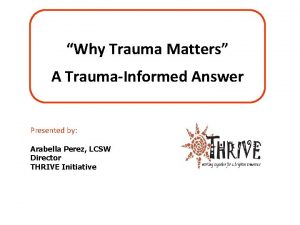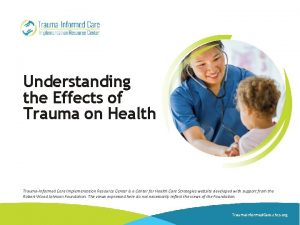Adverse Childhood Experiences and Electronic Cigarette Use among

- Slides: 1

Adverse Childhood Experiences and Electronic Cigarette Use among Young Australian Women Alemu Melka 1, 2, Catherine 1 Chojenta , Elizabeth 2 Holliday , Deborah 1 Loxton 1 Research Centre for Generational Health and Ageing, Faculty of Health and Medicine, The UON, Newcastle, 2 School of Medicine and Public Health, Faculty of Health and Medicine, The UON, Newcastle Background 25 Past year e-cigarette use Method 20 Prevalence (%) • Researchers have identified positive relationships between childhood adversities and smoking, problem drinking and illicit drug abuse. • Nonetheless, to our knowledge, in no studies has there been an examination of the association between adverse childhood experiences (ACEs) and ecigarette use. • This study aimed to investigate the association between ACEs and ecigarette use. 20. 54 Ever e-cigarette use 14. 67 15 12. 65 8. 5 10 6. 71 5 3. 94 7. 1 11. 74 8. 5 4. 81 0 0 ACEs 1 ACE 2 ACEs 3 ACEs 4+ ACEs ACE Score Fig 1: Prevalence of past year and ever e-cigarette use by ACE score among Australian • Data from the Australian Longitudinal Study on Women’s Health were used. • Study respondents (N= 8915) from the 1989 -95 cohort (third wave) aged 19 -26 years completed an online survey in 2015. • Chi-square test was used to compare individuals with missing and complete data by outcome variable (e-cigarette use) • Multivariate logistic regression analysis was used to examine the association between ACEs and ecigarette use, adjusted for sociodemographic variables and smoking status. Results • The prevalence of past year ecigarette use among the study participants was 6. 4% while the ever e-cigarette use was 11. 1%. • The prevalence of at least one reported ACE was 65. 2 %, while the prevalence of 4 or more ACEs was 14. 7%. • Both the prevalence of past year and ever e-cigarette use increased with the number of ACEs (Fig 1). • In the fully adjusted model the three childhood abuse variables (psychological, physical and sexual abuse) were positively associated with both past year and ever e-cigarette use. • In the fully adjusted analysis, the odds of past year e-cigarette use were Ø 1. 5 times higher for study participants exposed to psychological abuse Ø 1. 3 times higher for study participants exposed to physical abuse and Ø 1. 4 times higher for study participants exposed to sexual abuse compared with those who were not • Household Substance abuse, Witnessing Domestic Violence, lived with a mentally ill family member were also positively associated with ever e-cigarette use • A positive dose-response relationship was observed between the number of ACEs and the odds of e-cigarette use. Discussion • The prevalence of at least one ACE was higher (41%) compared to findings reported by Loxton and colleagues among Australian women aged 18 -23 years old • While we identified no previous studies investigating the relationship between ACEs and e-cigarette use, researchers have found that physical, emotional and sexual abuse are stronger predictors of smoking among women • In order to cope with anxiety and depression, individuals exposed to childhood adversities may be more likely to use nicotine to reduce negative emotions Conclusions • This study identified an association between ACEs and e-cigarette use. • Improvements in supportive parenting skills and the provision of counselling services for those exposed to ACEs may help avert health-harming behaviours, including ecigarette use. References 1. Felitti, V. J; et al. (1998). Relationship of childhood abuse and household dysfunction to many of the leading causes of death in adults: The Adverse Childhood Experiences (ACE) Study. Am J Prev Med, 14(4), 245 -258. 2. Campbell, et al. (2016). Associations between adverse childhood experiences, high-risk behaviors, and morbidity in adulthood. Am J Prev Med, 50(3), 344352. 3. Alcalá, H. E. , et al. (2016). Adverse childhood experiences and use of cigarettes and smokeless tobacco products. J Community Health, 41(5), 969 -976. 4. Loxton, et al. (2018). Adverse childhood experiences and healthcare costs in adult life. J Child Sex Abus, 1 -15. Acknowledgements • AM was supported by the University of Newcastle Ph. D scholarship. • We are indebted to the Australian Government Department of Health for financing the study Contact Alemusufa. melka@uon. edu. au

